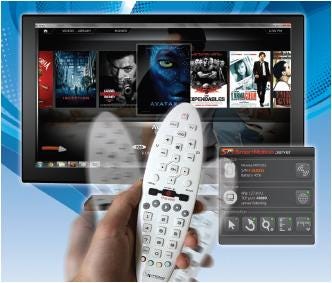Gesture Control Coming to a Television Near You
April 3, 2013

Pressing buttons on your television's remote may one day be passe. A new technology will enable couch potatoes to change channels, adjust the volume, rewind a movie, browse the Internet, or control myriad other functions with simple physical gestures. The technology, incorporated into a device called a SmartMotion Server, will not only interpret the swipes and rolls, but will understand what they mean in the context of different TV-related applications.
"It's actually aware," Tim Kelliher, customer solutions architect for Movea, creator of the new technology, told Design News. "Our server is aware if you are looking at a TV show, watching a movie, browsing the Web, looking at pictures, reading your email, or listening to music."
For viewers, the new server technology will mean a whole new control experience. A roll of the wrist, for example, might adjust the volume. Yawing the remote, meanwhile, might enable fast-forwarding or rewinding of a movie.

While learning a new repertoire of gestures might seem unnecessary to today's TV buffs, Movea says it's becoming important as televisions offer more Internet capabilities. "Consumers started asking for this type of capability as soon as they had Internet-connected TV," Kelliher told us. "They often don't have a mouse and they don't want to sit in a desk-like environment while they're watching TV. They're on the couch, so a mouse is cumbersome, whereas a flick of the wrist is not."
The trick to enabling such technology is to make it "contextually aware," Kelliher said. Awareness is important because different applications require gestures to have different meanings. A yawing motion might allow a viewer to scroll through a movie, for example, or enable a viewer to pan up and down while playing a video game. To make that happen, the system has to know which application is running.
The intelligence for the SmartMotion Server lies in the set-top box, not the remote. Using STMicroelectronics's Orly STiH416 set-top box system-on-chip (SOC), the server enables simple gestures to be understood and placed into context. The ARM-based dual-core SOC accomplishes that by communicating with three MEMS-based accelerometers and three gyroscopic sensors inside the remote.
During operation, a chip in the remote control reads the sensor data and transmits it via an RF link to the set-top-based server. The server then interprets the sensor data and maps it onto the application. In that way, the user's swipes and rolls are always interpreted within the correct context. "The system-on-chip is an enabler for us because it allows for the Internet context to be placed over the top of your standard TV services," Kelliher said.
In January, Movea (which is responsible only for the intellectual property, not the product hardware) deployed the SmartMotion Server in French-based Orange's Livebox Play TV set-top box. Movea told Design News that the technology was a natural extension of video games such as Ninetendo's Wii, which are gaining mainstream popularity. "When Wii became popular, a lot of service providers wanted to apply a similar experience to TV," Kelliher said. "That's when gestures started to come into play, and why they will be big in the future."
Related posts:
About the Author(s)
You May Also Like



